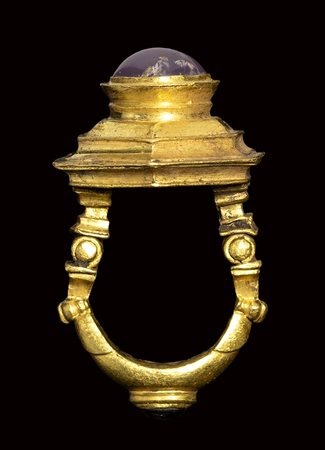 Bertolami Fine Art - Bertolami Fine Art, 1 Harewood Place 1, W1S 1BU Londra
Bertolami Fine Art - Bertolami Fine Art, 1 Harewood Place 1, W1S 1BU Londra
ASTA 107 - Glittica Sessione Unica
Friday 22 April 2022 hours 15:00 (UTC +00:00)
A late hellenistic architectural gold ring with stepped bezel set with amethyst and garnet. 2nd century B.C.
A late hellenistic architectural gold ring with stepped bezel set with amethyst and garnet.
2nd century B.C.
The complex construction is composed of an hollowed bezel with a series of sharply molded hexagonal steps set with a large cabochon amethyst. The hoop is solid and boat-shaped, terminating in architectural form (top of a column and capital). A small oval cabochon garnet is set in the center of the hoop at the bottom. The hoop attaches to the bezel by means of hinged elements held by pegs. Nearly twenty other similar rings are known. Although the rings display variations in shape and details, all the examples are very close in style and technique. The quality of both the gold work and the stones themselves is very high. Garnet is the most popular stone of the hellenistic period, but rings of this group are also set with amethyst, emeralds, and citrines.
Parallel: Marshall, F.H., Catalogue of the singer rings, British Museum, 1968, Pl.XXI, 843-844
Spier, J. - Ogden, J., rings of the ancient world, 2015, n°28, p.77, 78.
Stone diam. 11 mm (amethyst) and 4x6 mm (garnet); ring size 15 x 21 mm; H. 43 mm; 22,21 gr.
Provenance: english private collection B.C., London, acquired on the London art market in 1975.







